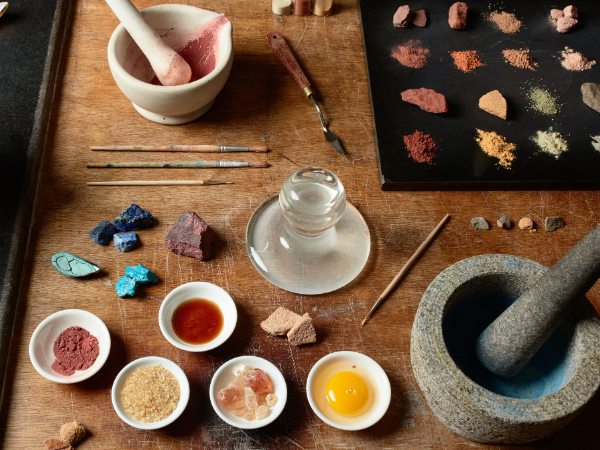Courses
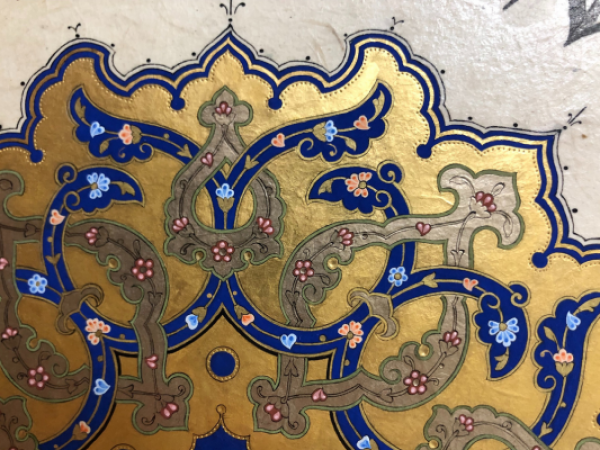 Islamic Manuscript Illumination: Flower-Inlaid Rumi Patterns
Rumî is the name of a motif found in traditional Ottoman decorative arts. Rumî compositions feature stylised animal figures such as birds, lions, deer, fish, and mythical...
Islamic Manuscript Illumination: Flower-Inlaid Rumi Patterns
Rumî is the name of a motif found in traditional Ottoman decorative arts. Rumî compositions feature stylised animal figures such as birds, lions, deer, fish, and mythical...
Rumî is the name of a motif found in traditional Ottoman decorative arts. Rumî compositions feature stylised animal figures such as birds, lions, deer, fish, and mythical creatures like dragons and the Simurgh.
During this course, students will learn to draw and paint a stunning variant of this motif, flower-inlaid Rumî.
To begin, students will learn the design rules before making their compositions. They will also learn how to prepare genuine gold and paint with it.
Alongside learning how to draw and paint these motifs, students will be given insights into technical considerations for illumination such as the traditional colour palette and different methods for shading flowers.
By the end of the course, students will have drawn, transferred and painted an art piece with flower-inlaid Rumî motifs.
Book now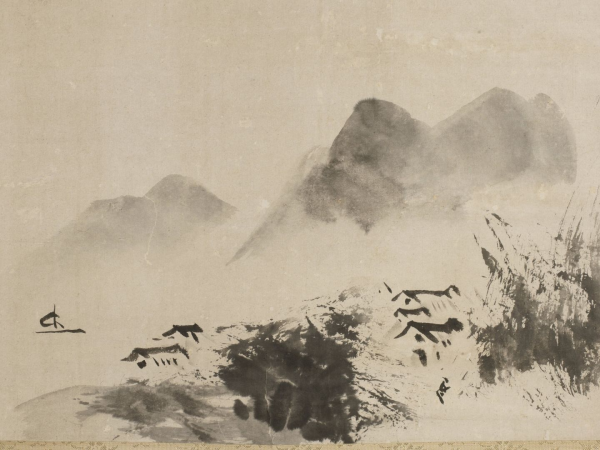 In the Alchemist's Studio: Black
Of all colours, black was one of the earliest pigments to be used by artists, evident in cave paintings over 60,000 years old. Symbolically black is the mother of colour, absorbing...
In the Alchemist's Studio: Black
Of all colours, black was one of the earliest pigments to be used by artists, evident in cave paintings over 60,000 years old. Symbolically black is the mother of colour, absorbing...
Of all colours, black was one of the earliest pigments to be used by artists, evident in cave paintings over 60,000 years old. Symbolically black is the mother of colour, absorbing all other colours and light. Black signifies the receptive, existing beyond time and space, and embodies primordial feminine wisdom—the source of the universe. It is the hidden darkness from which all light emerges.
We will focus on the particular significance of black in traditional Chinese ink making, a craft that dates back to the 12th century. This process involves creating black ink through the burning of resinous pine, resulting in a unique black that is regarded as the finest of all blacks. Additionally, we will examine other historical black pigments, such as ivory, bone, lampblack, and vine black, and discuss how an understanding of ink-making processes is essential to its creative ex
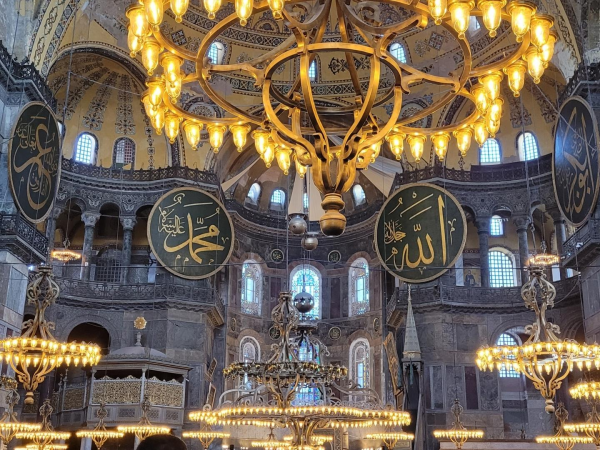 Arabic Calligraphy: The Roundels of Aya Sophia
Inspired by the Aya Sophia, recreate the striking calligraphy roundels by the Ottoman luminary Kazasker Mustafa İzzet Efendi (1901-1876). Practice the jali (large) thuluth...
Arabic Calligraphy: The Roundels of Aya Sophia
Inspired by the Aya Sophia, recreate the striking calligraphy roundels by the Ottoman luminary Kazasker Mustafa İzzet Efendi (1901-1876). Practice the jali (large) thuluth...
Inspired by the Aya Sophia, recreate the striking calligraphy roundels by the Ottoman luminary Kazasker Mustafa İzzet Efendi (1901-1876). Practice the jali (large) thuluth script and the techniques employed by Kazasker Efendi to write the roundels in pen and ink, an art form rooted in principles passed down through generations.
Through hands-on sessions develop your own smaller calligraphy roundels, featuring the sacred name of Allah or the name of the Prophet Muhammad. The Aya Sophia stands as an icon of global architecture. The historic roundels were meticulously placed during the 19th Century repairs. The mastery embedded in these monumental 7.5- metre roundels has left an indelible mark in the records of calligraphy history. The eight calligraphy roundels bear the names of Allah, the Prophet Muhammad, his grandsons Hasan and Hussein, and the four companions - all adorned with gold leaf against a rich dark background.
Book now Lovers in a Garden: Layla & Majnun
Explore Persian miniature painting through the love story of Layla and Majnun, a tale of intense, unfulfilled love popularised by the 12th-century poet Nizami Ganjavi. Layla and...
Lovers in a Garden: Layla & Majnun
Explore Persian miniature painting through the love story of Layla and Majnun, a tale of intense, unfulfilled love popularised by the 12th-century poet Nizami Ganjavi. Layla and...
Explore Persian miniature painting through the love story of Layla and Majnun, a tale of intense, unfulfilled love popularised by the 12th-century poet Nizami Ganjavi. Layla and Qays fall in love at school, and Qays becomes so consumed by his passion that he becomes known as Majnun (meaning "mad"), while Layla is forced to marry another. Despite their mutual love, the two ultimately die of heartbreak without ever being able to be together.
We focus on the scene of the lovers' meeting in a palm grove, contrasting the peaceful garden setting with their inner turmoil. You will learn to depict the lovers' glances, oasis vegetation, Majnun's wild appearance, and Layla's veiled beauty. The course covers traditional techniques for brushwork, paper and paint preparation, bringing this timeless story to life through art.
Book now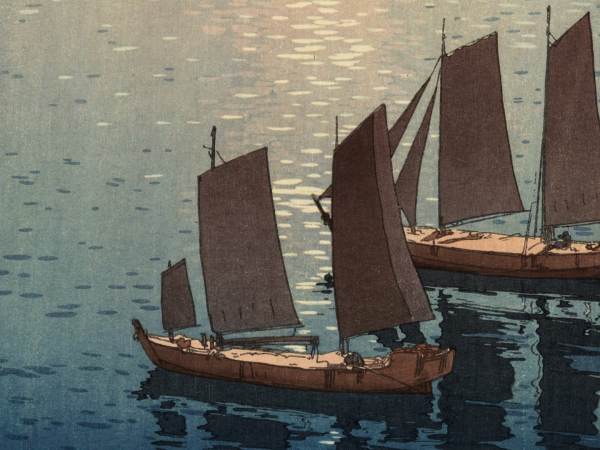 Japanese Woodblock Printmaking in Colour: Bokashi
Create a woodblock print in colour, inspired by the work of artists such as Onchi Koshiro and Kawase Hasui. This course employs slightly different techniques to our other...
Japanese Woodblock Printmaking in Colour: Bokashi
Create a woodblock print in colour, inspired by the work of artists such as Onchi Koshiro and Kawase Hasui. This course employs slightly different techniques to our other...
Create a woodblock print in colour, inspired by the work of artists such as Onchi Koshiro and Kawase Hasui. This course employs slightly different techniques to our other Japanese woodblock printing courses, and does not require the use of a key block. Instead, we use a more contemporary approach to create a design as Koshiro or Hasui would have done. You will also learn bokashi, a technique for achieving a gradation of tone in a colour or multiple colours.
Book now Persian Miniature Painting: Heavenly Architecture & Iskandar's Horoscope
Astrological charts lay out the heavenly structure of things. We will paint the famous Horoscope of Iskandar, grandson of Tamerlane the Conqueror. The position of the heavens...
Persian Miniature Painting: Heavenly Architecture & Iskandar's Horoscope
Astrological charts lay out the heavenly structure of things. We will paint the famous Horoscope of Iskandar, grandson of Tamerlane the Conqueror. The position of the heavens...
Astrological charts lay out the heavenly structure of things. We will paint the famous Horoscope of Iskandar, grandson of Tamerlane the Conqueror. The position of the heavens at the time of his birth is recorded in this wondrous 1411 Timurid manuscript painting. The stars align and fate is painted. We will think about how fate and destiny, time and magic intertwine in a painting to form a coalition of the arts and sciences: astronomy, calligraphy, illumination and painting gather to create a marvel of the book arts that is a beautiful record of a life. The starry skies hold everything together and the Zodiac signs are recognisable even today.
The pleasure of concentrating on a single miniature for a period of time involves us deeply. We are immersed in it; we live with it; we live in it. Inhabiting and internalising a painting in this way is a wonderful and traditional way to learn. In today’s fast-paced world we need to sit, focus on and contemplate our single piece and grow to love and understand it. We will understand the subtle art of colour, composition and blending by our action of making and doing, connecting with the work. The aim is not to rush, but to dwell. Thus painting is a form of meditation in itself. Students are invited to recreate this work alongside the tutor, incorporate elements into existing work or be inspired to create their own astrological or heavenly compositions, perhaps even a fictitious (or real) horoscope.
Book now
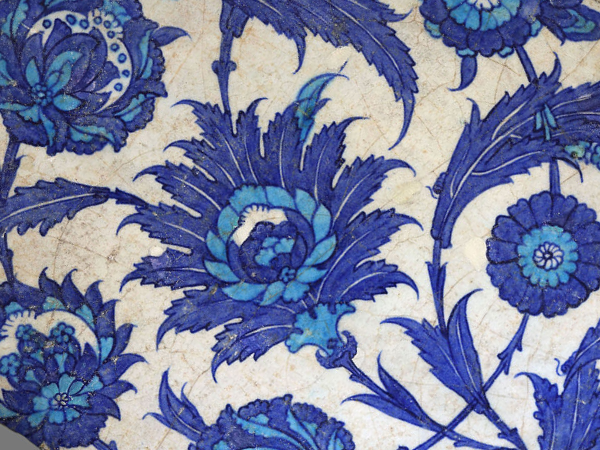 Ceramics: Design & Glaze Iznik Tiles
Iznik tiles get their name from the Turkish town of Iznik where they were first made, starting in the 15th century. The tiles are easily recognised by their intricate floral...
Ceramics: Design & Glaze Iznik Tiles
Iznik tiles get their name from the Turkish town of Iznik where they were first made, starting in the 15th century. The tiles are easily recognised by their intricate floral...
Iznik tiles get their name from the Turkish town of Iznik where they were first made, starting in the 15th century. The tiles are easily recognised by their intricate floral designs and palette of cobalt blue, turqouise, and bole red against a glossy white background.
Students will design and glaze a set of tiles. Beginning with design, learn a vocabulary of traditional floral forms. Students will then move on to testing glaze colours and finally painting the designs onto bisque tiles.
Please note that the tiles require time to dry and be fired. Students will be asked to return after the course is over to collect their fired tiles.
Book now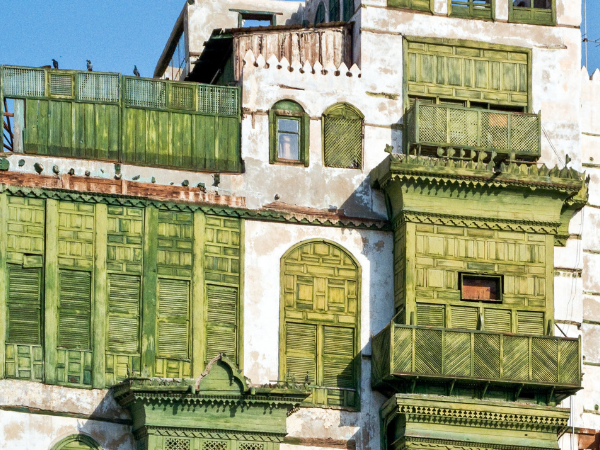 Build a Geometric Wooden Screen: Mangour
A mangour screen is a form of decorative wooden latticework. Assembled from an interlocking system of geometric wooden pieces, they are held together without nails or glue. These...
Build a Geometric Wooden Screen: Mangour
A mangour screen is a form of decorative wooden latticework. Assembled from an interlocking system of geometric wooden pieces, they are held together without nails or glue. These...
A mangour screen is a form of decorative wooden latticework. Assembled from an interlocking system of geometric wooden pieces, they are held together without nails or glue. These screens can still be seen on the decorated bay windows and interiors of Jeddah's historic homes, exhibiting a rich variety of forms.
In this practical workshop, discover how the geometric language of mangour and construction methods combine to produce a beautiful design. The course begins with an introduction to the alphabet of geometric shapes that can be used, and how the geometry translates to wood. Students will then be shown carving techniques, and how to work with a chisel and mallet to craft the interlocking pieces.
By the end of the course, students can expect to leave with a small carved screen panel and have an understanding and appreciation of this craft.
Book now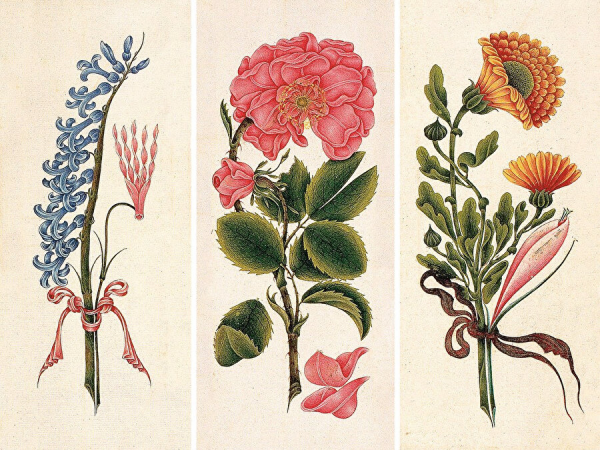 Ottoman Miniature Painting: A Floral Bouquet
This short course provides an immersive exploration of floral painting techniques inspired by the rich traditions of the Ottoman Empire. Focusing on the style of the painter Ali...
Ottoman Miniature Painting: A Floral Bouquet
This short course provides an immersive exploration of floral painting techniques inspired by the rich traditions of the Ottoman Empire. Focusing on the style of the painter Ali...
This short course provides an immersive exploration of floral painting techniques inspired by the rich traditions of the Ottoman Empire. Focusing on the style of the painter Ali Uskudari, students will master detailed brushwork, vibrant color layering, and delicate shading to bring floral subjects to life. They will learn to capture the essence of Ottoman floral motifs using traditional painting methods, gaining hands-on experience with these unique techniques along the way.
Book now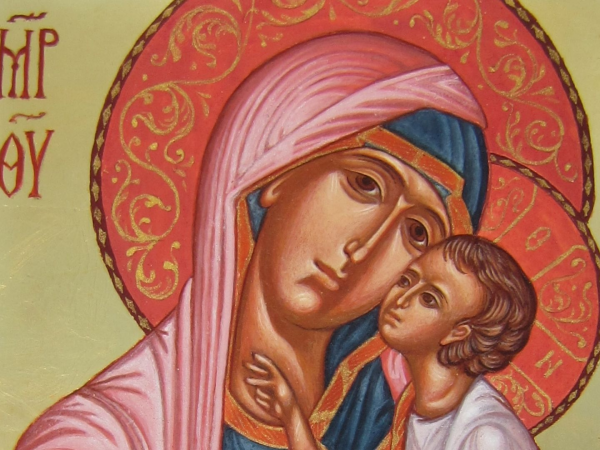 Byzantine Icon Painting: Designing a Patterned Halo
This course is designed to provide an introduction to all aspects of Byzantine icon painting and to teach students how to create their own patterns for halos.
Students will...
Byzantine Icon Painting: Designing a Patterned Halo
This course is designed to provide an introduction to all aspects of Byzantine icon painting and to teach students how to create their own patterns for halos.
Students will...
This course is designed to provide an introduction to all aspects of Byzantine icon painting and to teach students how to create their own patterns for halos.
Students will learn various gilding techniques and how to paint with traditional egg tempera, which is made with natural and semi-precious pigments, on gessoed wooden boards.
The tutor will paint alongside the class to demonstrate each process and stage of this traditional art form, serving as a guide for students to follow. Additionally, the course will include a brief introduction to the history of icon painting, exploring their significance and discussing why icons are still painted today from the perspective of a practicing artist.
Book now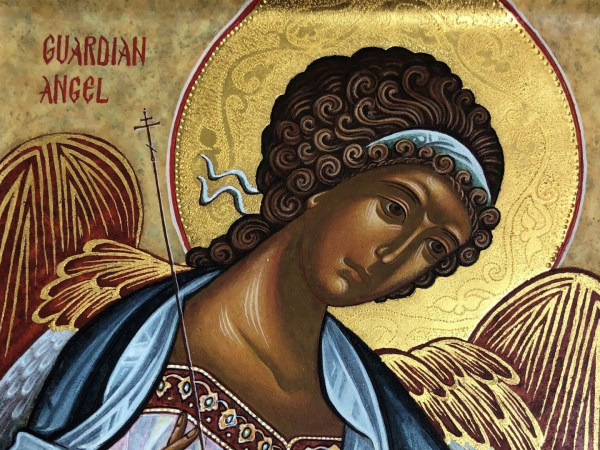 Byzantine Icon Painting: Paint a Guardian Angel
This course provides an introduction to all aspects of traditional Byzantine icon painting. The aim is to understand the history and meaning of icons, as well as painting one.
...
Byzantine Icon Painting: Paint a Guardian Angel
This course provides an introduction to all aspects of traditional Byzantine icon painting. The aim is to understand the history and meaning of icons, as well as painting one.
...
This course provides an introduction to all aspects of traditional Byzantine icon painting. The aim is to understand the history and meaning of icons, as well as painting one.
Students will learn to paint in translucent layers of egg tempera, using natural and semi-precious pigments. The course will also cover using clay and gold leaf for gilding.
The tutor will paint along with students on her icon, to demonstrate each step in an easy-to-follow way.
The focus of this course will be painting an icon of a guardian angel.
Book now
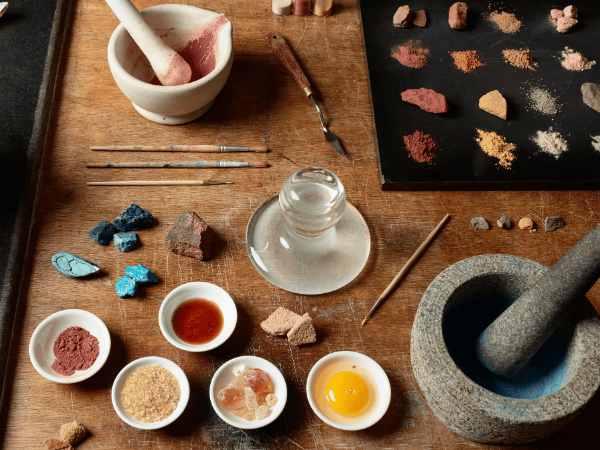 The Alchemy of Colour
The earth is the natural apothecary of the arts; hidden within its depths are all the variety of pigments as seen in the great paintings and galleries of the world. During this...
The Alchemy of Colour
The earth is the natural apothecary of the arts; hidden within its depths are all the variety of pigments as seen in the great paintings and galleries of the world. During this...
The earth is the natural apothecary of the arts; hidden within its depths are all the variety of pigments as seen in the great paintings and galleries of the world. During this workshop, students will explore the traditional processes by which these pure pigments are extracted from their natural sources in the form of earth, rocks, roots and berries, and how these are transformed into pure pigments.
The traditional methods used to transform these raw materials were, in earlier times, a natural part of the traditional training of the artist; the process of preparing these natural materials was seen as an integral part of the painting process and was not separate from the painting. These craft practices are a journey into the very heart of the creative process, preparing the artist both outwardly and inwardly.
Working with the semi-precious rocks malachite, azurite, cinnabar and chrysocolla, as well as certain plant colours (Madder roots and Persian berries), students will discover first-hand the miraculous processes by which these raw materials are ground, washed, purified and, in some cases, heated and precipitated, and slowly transformed into luminous jewel-like pigments.
In the second part of this five-day workshop, students will be taught about traditional recipes and how these pure pigments can be made into handmade paints using gum arabic, egg tempera and oil. As well as producing pigments from plant dyes, students will also have the opportunity to experiment with tie-dying techniques on silk using gardenia and Brazil wood dyes.
Book now
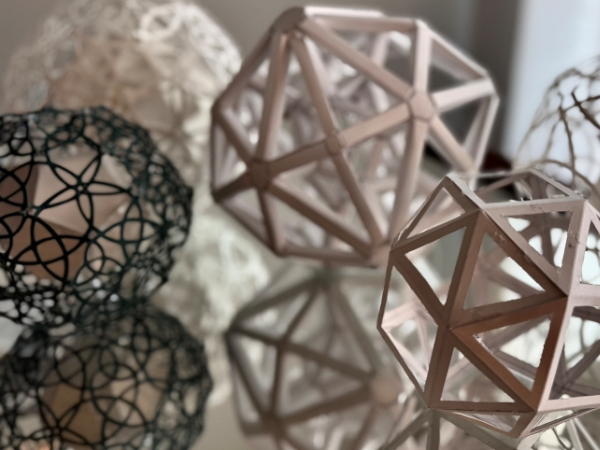 Seeing Through the Solids: The Hidden Geometries of the Archimedean
This course reintroduces the Archimedean solids through a new methodology, emphasizing the unseen internal spaces that belong to this foundational set of polyhedra. It explores how...
Seeing Through the Solids: The Hidden Geometries of the Archimedean
This course reintroduces the Archimedean solids through a new methodology, emphasizing the unseen internal spaces that belong to this foundational set of polyhedra. It explores how...
This course reintroduces the Archimedean solids through a new methodology, emphasizing the unseen internal spaces that belong to this foundational set of polyhedra. It explores how these thirteen shapes not only relate to their platonic origins but also exist in an active relationship with each other.
This expansive approach challenges the way that these forms have been conventionally understood and opens new doors for creative exploration.
Here students will be led through a hands-on process of nesting Archimedean forms within each other while observing how the angles within each form must be adjusted to accommodate different arrangements. Attendees will construct nets of a unique group of intermediary shapes and develop skills in ruler, compass, and paper craft to aid in future experimentation.
Through constructing these forms by hand students will gain a unique understanding of the internal composition of the Archimedean system, its parts, and their relationships as they may benefit fields of sculpture, architecture, and 3D design.
Book now
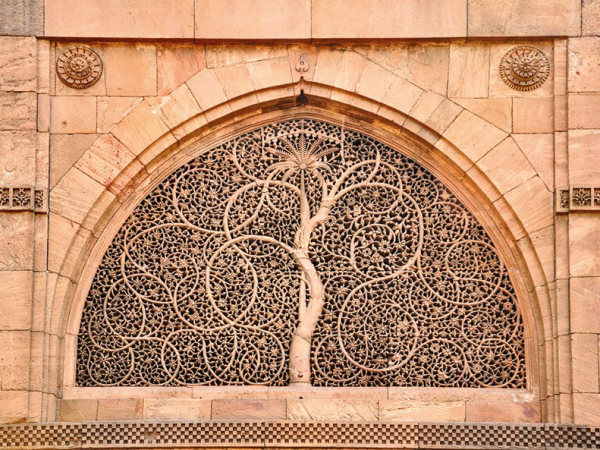 Egg Tempera: Painting a Tree of Life
Throughout history, the 'Tree of Life' has been depicted in different ways across many religions and cultures. Explore the symbolism of this motif, before painting your own design....
Egg Tempera: Painting a Tree of Life
Throughout history, the 'Tree of Life' has been depicted in different ways across many religions and cultures. Explore the symbolism of this motif, before painting your own design....
Throughout history, the 'Tree of Life' has been depicted in different ways across many religions and cultures. Explore the symbolism of this motif, before painting your own design. Choose to paint an image from history or your imagination.
Then consider the background of the painting - It may be set in a garden, landscape, or an individual vision. Plan the atmosphere of your painting through a series of colour harmony studies relating colour to nuance. Decide upon the palette and time of day in which the tree is situated.
In this course we will be using the medium of egg tempera, working with artists' pigments. Students will practice different techniques including working with a larger size brush as well as smaller brushes for fine work, dry brush and glazing.
In this course we will be using the medium of egg tempera, working with artists' pigments and medium. Students will practice different techniques including working with a larger size brush before switching to smaller brushes for dry brush and glazing.
Book now
 Designing Earth Architecture: Vaults & Domes
Gain hands-on experience in how masons built traditional domed structures such as churches, mosques, tombs, palaces, and simple homes using just one material - earth. Learn the...
Designing Earth Architecture: Vaults & Domes
Gain hands-on experience in how masons built traditional domed structures such as churches, mosques, tombs, palaces, and simple homes using just one material - earth. Learn the...
Gain hands-on experience in how masons built traditional domed structures such as churches, mosques, tombs, palaces, and simple homes using just one material - earth. Learn the techniques to rotate and incline small blocks of natural materials to create arches, vaults, and domes, allowing you to design in harmony with the Earth. Engage in full-scale exercises and model-building activities to understand the timeless design principles that can inspire the creation of new homes, places of worship, and community spaces.
This course seeks to re-awaken a method, latent in the world’s diverse religious systems, of architectural design and building construction as an orderly process of spiritual guidance. In the process of “research and in-search” our quests become more meaningful when our goals meet with others' needs and goals (Khalili, 1984)
The content of this course includes one of the most ancient frames of reference: Masonry Architecture. It provides the participant with an ancient mnemonic, like a string of prayer beads or a ladder of ascent and descent. Continuing the essence of its tradition into the 21st century, digital fabrication with traditional masonry are integrated, building on the work of Masters.
"An arch is like a prayer,
its strength is in its unity,
its beauty in its repetition."
The course content addresses building with earth and masonry as a living art, relating historical precedent and contemporary practice. You will be learning to work with the universal elements of earth, water, air and fire as architectural design generators and innovators, within a design theory that works with their properties and qualities (divine names) and the process of analogy. The principle of unity within diverse multiplicity is explored through work “made without hands” (acheiropoeiton) and “doing while not doing” (anenergesia) in the design and fabrication of masonry buildings.
Lectures in theory are followed by hands-on building scale models and full-scale architectural elements. Both theory and hands-on teach a gravity-guided architecture experienced by all the senses.
Book now
 Moroccan Ceramic Tiles: Zillij
This course introduces students to the art of Zillij, a ceramic tile style found throughout the Islamic world, particularly in Morocco. Students will be shown a variety of tile...
Moroccan Ceramic Tiles: Zillij
This course introduces students to the art of Zillij, a ceramic tile style found throughout the Islamic world, particularly in Morocco. Students will be shown a variety of tile...
This course introduces students to the art of Zillij, a ceramic tile style found throughout the Islamic world, particularly in Morocco. Students will be shown a variety of tile-making techniques, and create a panel composition to take home with them.
Book now Dyeing with Natural Pigments
Uncover the rich, vibrant world of natural dyeing in this practical course that celebrates colour sourced directly from the earth. Guided by traditional techniques from the Middle...
Dyeing with Natural Pigments
Uncover the rich, vibrant world of natural dyeing in this practical course that celebrates colour sourced directly from the earth. Guided by traditional techniques from the Middle...
Uncover the rich, vibrant world of natural dyeing in this practical course that celebrates colour sourced directly from the earth. Guided by traditional techniques from the Middle East, Africa and Europe, you’ll learn how to transform animal and plant-based fibres using traditional methods and natural materials.
Explore a wide palette of natural dyes including madder, cochineal, indigo, mud, sidr, lac and master essential processes like mordanting, surface dyeing and the use of colour modifiers to achieve a full spectrum of long-lasting hues. From identifying dye-producing plants to developing environmentally responsible dyeing practices, this course offers a comprehensive, practical journey into the world of natural colour.
Perfect for craftspeople, textile artists and beginners, this course is both inspiring and deeply rooted in traditional knowledge giving you the skills and confidence to continue your dyeing journey long after the course ends.
Book now
 Patterns in Porcelain
Porcelain is a unique medium: the plasticity of its particles lends itself to fine detail, its whiteness, uncontaminated by other earth oxides, reflects light and gives a...
Patterns in Porcelain
Porcelain is a unique medium: the plasticity of its particles lends itself to fine detail, its whiteness, uncontaminated by other earth oxides, reflects light and gives a...
Porcelain is a unique medium: the plasticity of its particles lends itself to fine detail, its whiteness, uncontaminated by other earth oxides, reflects light and gives a particular luminosity to glazes, and its high-vitrification point makes it incredibly durable and translucent when illuminated.
During this five-day workshop, the participants will be introduced to porcelain’s enchanting history: used in China as early as 7th century A.D., attempts to recreate true porcelain in Europe seemed like an act of alchemy and magic. Taking it out of its utilitarian and industrial context, we will engage in the drawing and making process using plaster moulds to impress design details onto the clay surface. We will consider a range of making techniques, there will be an opportunity to experiment with matte and transparent glazes, and we will also consider the effects of kiln firing processes.
By the end of the course, each participant will have completed a small panel or a series of repeating design elements, where the designs are incised or in relief on the surface of porcelain, and will be equipped with skills for further experimentation and exploration into the beauty and functionality of this medium.
Participants are encouraged to bring their own circular or square design composed of geometric and/or biomorphic motifs or may choose from a range of designs supplied by the tutor.
Book now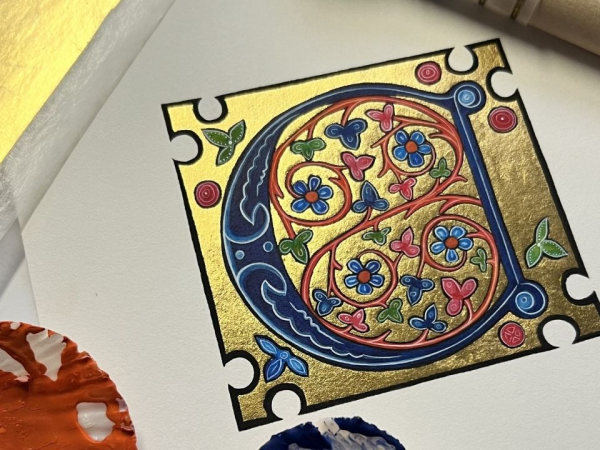 Illuminating William Morris
The artist, poet, designer, and publisher, William Morris, was deeply moved by illuminated manuscripts he saw in Canterbury Cathedral as a child. Later, while studying at Oxford,...
Illuminating William Morris
The artist, poet, designer, and publisher, William Morris, was deeply moved by illuminated manuscripts he saw in Canterbury Cathedral as a child. Later, while studying at Oxford,...
The artist, poet, designer, and publisher, William Morris, was deeply moved by illuminated manuscripts he saw in Canterbury Cathedral as a child. Later, while studying at Oxford, he encountered more manuscripts at the Bodleian Library that inspired him to try his hand at illumination. Morris eventually integrated ideas and designs from these manuscripts, along with other sources, into the books he published through the Kelmscott Press.
During this class, we will delve into the illustrious history of illuminated manuscripts, exploring how these exquisite works inspired William Morris’s Kelmscott Press books. Students will have opportunity to view one such book, The Story of the Glittering Plain, during a private visit to The King's Gallery at Buckingham Palace. In this journey, we will encounter the captivating beauty and craftsmanship that define these books.
In this immersive course, explore the ancient technique of painting on calfskin vellum. Learn to work with pigments from both botanical sources such as woad as well as colours from mineral deposits, then try your hand at traditional gilding methods to bring light to the page with gold leaf. Conclude the class by painting your own personalised manuscript border and illuminated letter inspired by the magical allure of William Morris’s beautiful book designs.
Book now Painting Visions of Heavenly Jerusalem
For millennia, the Heavenly Jerusalem has been portrayed in illuminated manuscripts, panel paintings, and frescoes as a vision of divine perfection, its multi-layered and...
Painting Visions of Heavenly Jerusalem
For millennia, the Heavenly Jerusalem has been portrayed in illuminated manuscripts, panel paintings, and frescoes as a vision of divine perfection, its multi-layered and...
For millennia, the Heavenly Jerusalem has been portrayed in illuminated manuscripts, panel paintings, and frescoes as a vision of divine perfection, its multi-layered and scriptural content illustrated through geometric harmony and golden light.
Delve into the rich artistic tradition and symbolism of this theme, exploring its many historical representations before creating your interpretation. Participants will develop and paint their compositions in egg tempera or watercolour, learning to mindfully prepare natural pigments for as they work towards their artistic vision of the Heavenly Jerusalem.
This course is perfect for artists interested in sacred themes, architectural composition, and symbolic painting through a creative and meditative approach in the contemporary context.
Book now Stained Glass: A Closer Look at the Montrose Panels
During this course, students will make their own stained glass panels inspired by the Montrose Panels. Carved in oak, the panels were originally made in 1520 for a hospital...
Stained Glass: A Closer Look at the Montrose Panels
During this course, students will make their own stained glass panels inspired by the Montrose Panels. Carved in oak, the panels were originally made in 1520 for a hospital...
During this course, students will make their own stained glass panels inspired by the Montrose Panels. Carved in oak, the panels were originally made in 1520 for a hospital founded by the Abbot of Cambuskenneth.
The carvings feature plants suffused with Christian symbolism: roses for the Virgin Mary, grapes and vines for Christ and his followers, the Scottish bluebell stands for humility and gratitude, and the oak tree represents Christ's strength in adversity.
These panels are beautiful in their simplicity and have been created with great thought and meaning. For this reason, the tutor has chosen six different panels which are well suited to being translated into stained glass. Even though the designs are pre-made you will have freedom to make them your own through the way you paint them.
Students will work on two projects throughout the course. The first project involves painting a readymade design from the panels on clear glass, providing a solid foundation for working with paint on this medium, including line work and creating subtle tonal variations.
The second project will consist of making a panel from a choice of six readymade designs based directly on imagery from the panels. These will be made by you cutting different pieces of coloured glass. You will then paint and fire the pieces of glass, apply leading, ultimately finishing the panels with lead putty. Depending on time constraints, students who complete two layers of painting may have the opportunity to apply silver stain.
You will leave at the end of the week with one finished coloured stained glass panel and one clear piece of painted glass. You will have the option to solder hanging hooks onto both pieces if you would like.
Book now
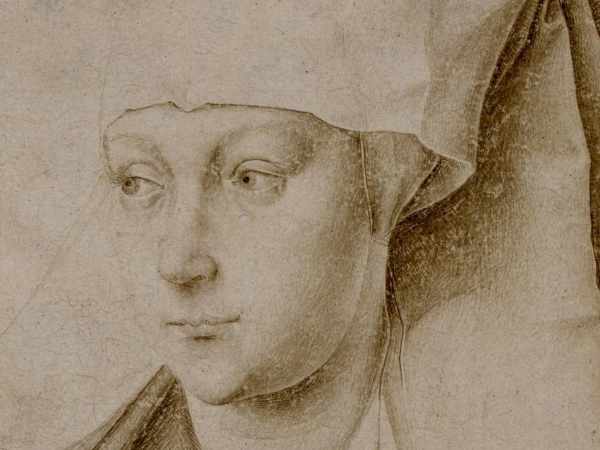 Drawing with Silverpoint
The practice of metal point drawing dates back to antiquity. In Europe from the 14th century to 16th century metalpoint was the popular medium for drawing. Each of the metals or...
Drawing with Silverpoint
The practice of metal point drawing dates back to antiquity. In Europe from the 14th century to 16th century metalpoint was the popular medium for drawing. Each of the metals or...
The practice of metal point drawing dates back to antiquity. In Europe from the 14th century to 16th century metalpoint was the popular medium for drawing. Each of the metals or alloys possess different physical characteristics, each metal giving a different type of stroke with subtle difference in hue also. In order for the metalpoint to create an clear flowing line, the paper or parchment requires to be carefully prepared. Ceninno Ceninno in the late 14th century describes preparing the surface with crushed chicken bones, chalk or white lead. As the metal is drawn across the surface, tiny particles of metal are left behind, creating a mark. Often the paper would also be given a pale tint created by mixing earth pigments with a little animal glue, this also gave the possibility of creating highlights with the addition of white. By the 15th century silver became the most popular metal to use for this technique, artists made use of the natural tarnishing qualities of the metal, resulting in the line becoming slightly darker with age. Other metals used were tin, bismuth, lead, gold and copper.
During this workshop students will be taken through a range of exercises using silverpoint. Students will learn how to prepare their own traditional grounds for silverpoint drawing as described by Cennino Cennini using ground bones and chalk. Students will prepare a range of different coloured surfaces onto which they will make studies from old master drawings as well as creating their own subjects, exploring the possibilities of this beautiful technique and their use on coloured grounds.
Book now Geometry Summer School 2025: Sacred Architecture & the Cosmos
The King’s Foundation is pleased to announce the 2025 Geometry Summer School. This year for the very first time, the Geometry Summer School will be taking place in North...
Geometry Summer School 2025: Sacred Architecture & the Cosmos
The King’s Foundation is pleased to announce the 2025 Geometry Summer School. This year for the very first time, the Geometry Summer School will be taking place in North...
The King’s Foundation is pleased to announce the 2025 Geometry Summer School. This year for the very first time, the Geometry Summer School will be taking place in North America. Join a team of expert tutors in the stunning Rocky Mountains for an intensive week investigating the geometry and cosmology of sacred architecture.
The Summer School programme will include practical geometry sessions, hand drawing and 3D construction activities, and illustrated presentations on sacred buildings from a variety of spiritual traditions including megalithic structures, the Great Pyramid, mosques, cathedrals, and Hindu temples.
A full programme will be released in the coming weeks.
Book now Sourcing from Nature: Make a feather quill & oak gall ink
Discover how to make your own blackest of inks from nature, using Britain's oldest ink recipe from oak galls found in the forests of Sussex.
Oak gall ink was commonly used for...
Sourcing from Nature: Make a feather quill & oak gall ink
Discover how to make your own blackest of inks from nature, using Britain's oldest ink recipe from oak galls found in the forests of Sussex.
Oak gall ink was commonly used for...
Discover how to make your own blackest of inks from nature, using Britain's oldest ink recipe from oak galls found in the forests of Sussex.
Oak gall ink was commonly used for drawing by artists such as Leonardo da Vinci, Michelangelo and Rembrandt. Much of Britain's most famous literature was written using oak gall ink including works by William Shakespeare, John Milton, William Wordsworth and Jane Austen; it was common practice for these writers to prepare their own oak gall ink using their own personal recipes.
Having spent the morning making a most exquisite ink, students will then be taught how to cut and prepare their own quills for drawing and writing.
This one day workshop will conclude with students making their own sketches using ink and quill on watercolour paper.
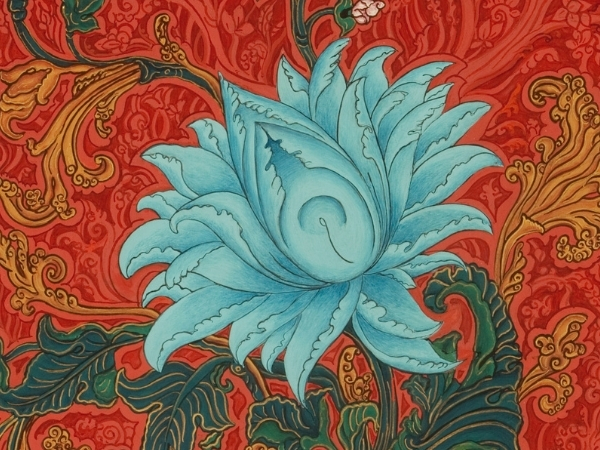 Floral Patterns in the Newar Buddhist Painting Tradition
Every sentient being is born with the seed of Buddhahood within. To truly realize this potential, one must nurture this seed. The lotus flower, a key motif in Buddhist art,...
Floral Patterns in the Newar Buddhist Painting Tradition
Every sentient being is born with the seed of Buddhahood within. To truly realize this potential, one must nurture this seed. The lotus flower, a key motif in Buddhist art,...
Every sentient being is born with the seed of Buddhahood within. To truly realize this potential, one must nurture this seed. The lotus flower, a key motif in Buddhist art, symbolizes this profound state.
Floral patterns reflect heavenly beauty and ambiance, conveying a deep interconnection between nature and the divine. The artistic vision in Buddhist paintings flourishes alongside a rich variety of flowers and vegetation.
During this online course, students will not only learn how to draw different kinds of lotuses, but they will also learn to paint and shade them based on the traditional Newar Buddhist painting tradition, Paubha, and understand the symbolism and philosophy behind it.
Students will have an opportunity to work in tandem with the tutor in creating many different kinds of lotuses and enjoy the process of painting and shading.
Book now

